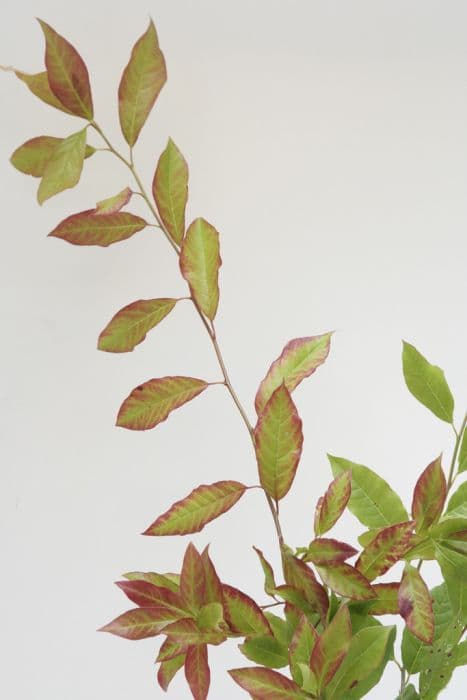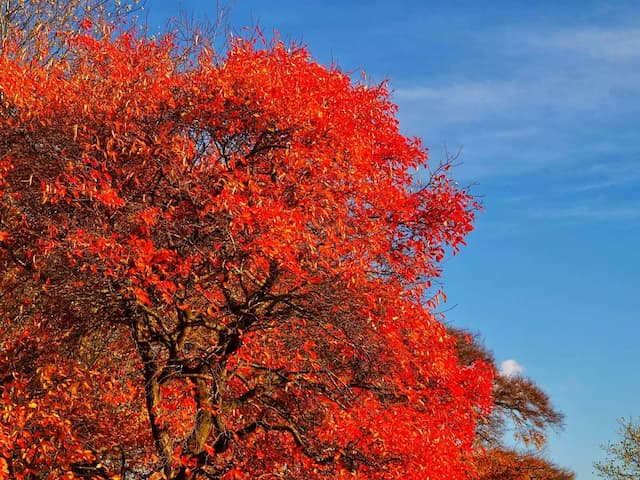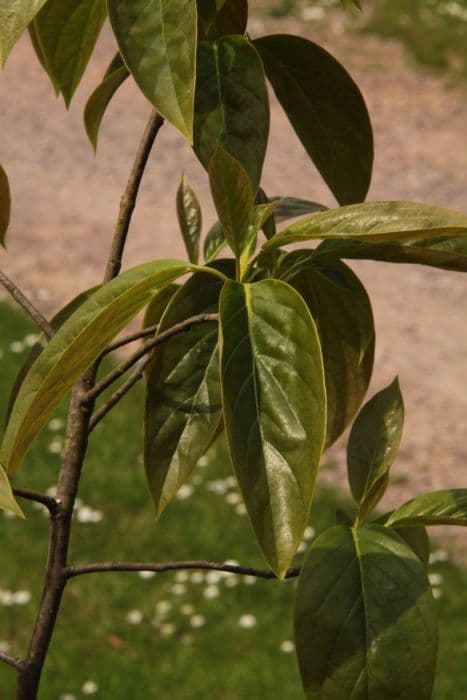Black Tupelo Nyssa sylvatica 'Wisley Bonfire' (m)

ABOUT
The Nyssa sylvatica 'Wisley Bonfire', commonly known as the Black Tupelo or Black Gum, is a visually striking plant. It features glossy, oval-shaped leaves that change dramatically with the seasons. During spring and summer, the foliage is a deep green, providing a lush, dense canopy. As autumn arrives, the leaves undergo a remarkable transformation. The green fades into fiery shades of orange, red, and purple, reminiscent of a bonfire's flames, which is likely the inspiration for its cultivar name 'Wisley Bonfire'. The vibrant fall color is one of its most distinguishing characteristics, creating a spectacular display in any landscape. The flowers of the Black Gum are relatively inconspicuous, small, and greenish-white, appearing in the late spring. They give way to bluish-black fruit that is quite popular with birds and wildlife. The fruits are small and not particularly noticeable to the casual observer, but they add an additional layer of interest for nature enthusiasts. The Black Gum's bark is deeply furrowed, providing textural contrast throughout the year. It has a strong, scaffold-like branching pattern that forms an attractive, irregular shape as the tree matures. This striking branching structure is particularly noticeable in the winter months when the leaves have fallen. The overall appearance of the Black Gum is one that exudes natural elegance and provides seasonal interest, making it a cherished addition to any garden or landscape that aims to display a progression of beauty throughout the year.
About this plant
 Names
NamesSynonyms
Black Gum, Tupelo, Black Tupelo, Sour Gum
Common names
Nyssa sylvatica 'Wisley Bonfire'
 Toxicity
ToxicityTo humans
The Black Tupelo is generally not considered to be toxic to humans. There are no well-documented cases of poisoning from ingesting parts of this plant, and it does not appear on lists of toxic plants. Consuming any plant not typically regarded as food should still be done with caution, and if any adverse reactions are suspected, medical advice should be sought.
To pets
The Black Tupelo is not known to be toxic to pets. It does not appear on toxic plant lists for animals such as dogs and cats, and no specific symptoms of poisoning are noted in veterinary literature. However, it is generally advisable to prevent pets from ingesting plants that are not part of their normal diet, as they may cause digestive upset or other non-toxic reactions. If a pet exhibits unusual symptoms after consuming any part of the plant, consult a veterinarian.
 Characteristics
CharacteristicsLife cycle
Perennials
Foliage type
Deciduous
Color of leaves
Green
Height
30 feet (9 meters)
Spread
20 feet (6 meters)
Plant type
Tree
Hardiness zones
4-9
Native area
North America
Benefits
 General Benefits
General Benefits- Attractive Foliage: Nyssa sylvatica 'Wisley Bonfire', commonly known as Black Tupelo, has leaves that change color in the fall, displaying vibrant reds, orange, and yellows, adding aesthetic value to landscapes.
- Shade Provider: As a medium to large tree, Black Tupelo offers ample shade in gardens and parks, making outdoor spaces more comfortable during hot weather.
- Wildlife Support: The tree produces small fruits that are a food source for birds and wildlife, supporting biodiversity.
- Erosion Control: The strong root system of Black Tupelo helps to stabilize soil and control erosion, particularly useful in sloped areas.
- Adaptable Growth: Black Tupelo is adaptable to a range of soil types and conditions, though it prefers acidic, well-drained soils, making it relatively easy to incorporate into diverse landscapes.
- Low Maintenance: Once established, it requires minimal maintenance, making it a practical choice for those seeking a low-maintenance landscaping option.
- Seasonal Interest: In addition to its fall foliage, Black Tupelo has inconspicuous spring flowers and an interesting winter silhouette, providing year-round interest.
- Durable Wood: The wood of Black Tupelo is hard and resistant to wear, making it useful for applications where durability is required, such as in tool handles and furniture.
- Carbon Sequestration: As a large deciduous tree, it plays a role in carbon sequestration, helping to mitigate climate change by absorbing carbon dioxide from the atmosphere.
- Heat Tolerance: Black Tupelo can withstand urban heat islands and is tolerant of higher temperatures, making it suitable for city planting.
- Pollinator Friendly: The flowers attract bees and other pollinators, which are essential for maintaining healthy ecosystems and food production.
 Medical Properties
Medical PropertiesThis plant is not used for medical purposes.
 Air-purifying Qualities
Air-purifying QualitiesThis plant is not specifically known for air purifying qualities.
 Other Uses
Other Uses- Wildlife habitat: Black Tupelo provides shelter and nesting sites for birds and small mammals.
- Bonsai: Due to its attractive foliage and structure, it can be used to create beautiful bonsai specimens.
- Photography: The fiery fall colors of Black Tupelo make it a popular subject for nature photography.
- Educational tool: It can be used in educational settings to teach about native trees and seasonal changes.
- Artistic inspiration: Artists may use the striking autumn colors of Black Tupelo as inspiration for various forms of art.
- Leaf castings: Its leaves can be used to make decorative castings for crafts and ornamentation.
- Woodworking: The wood, though not commonly used, can be crafted into unique wooden objects or turned items.
- Natural dye: The leaves and bark may be used to produce natural dyes for textiles.
- Seasonal celebrations: The tree’s vibrant fall colors lend themselves well to harvest-themed decorations and festivities.
- Culinary exploration: While not a common use, the fruit may be experimented with in culinary dishes, syrups, or preserves.
Interesting Facts
 Feng Shui
Feng ShuiThe Black Gum tree is not used in Feng Shui practice.
 Zodiac Sign Compitability
Zodiac Sign CompitabilityThe Black Gum tree is not used in astrology practice.
 Plant Symbolism
Plant Symbolism- Change and Transformation: The Nyssa sylvatica, commonly known as Black Tupelo or Black Gum, is renowned for its striking autumn foliage that changes from green to vibrant shades of red, orange, and purple. This transformation symbolizes the inevitability of change and the beauty in life's transitions.
- Resilience and Adaptability: The Black Tupelo is known for its ability to thrive in a variety of soil conditions, including wet, swampy areas. As a symbol, it represents the strength to adapt to and withstand challenging environments and circumstances.
- Longevity and Stability: This species can live for hundreds of years, signifying enduring presence, stability, and the importance of strong foundations in one's life.
 Water
WaterThe Black Tupelo should be watered deeply, allowing the water to penetrate several inches into the soil to reach the roots. During the first growing season, establish a good watering routine by providing about 1.5 gallons of water per week. Once established, it can withstand some drought, but it's best to water it every two to three weeks, adjusting for rainfall and soil conditions. During dry spells, increase watering to once a week, ensuring the soil stays moist but not waterlogged.
 Light
LightThe Black Tupelo thrives in full sun to partial shade. It prefers a spot that receives at least 4 to 6 hours of direct sunlight each day. While it can tolerate light shade, the most vibrant fall foliage color is achieved in a location where it is exposed to ample sunlight.
 Temperature
TemperatureThe Black Tupelo is hardy and can survive in a temperature range from as low as -30°F up to 100°F. The ideal temperature conditions for this tree range between 50°F and 70°F. It is suitable for USDA Hardiness Zones 4 through 9, indicating its resilience to varying weather patterns.
 Pruning
PruningPruning the Black Tupelo should be done to remove any dead, diseased, or crossed branches to maintain plant health and aesthetics. The best time to prune is in late winter to early spring before new growth starts. Typically, this tree requires minimal pruning, and it's generally recommended to prune it every 2 to 3 years.
 Cleaning
CleaningAs needed
 Soil
SoilBlack tupelo 'Wisley Bonfire' prefers acidic, moist, well-draining soil, with a pH between 5.5 and 6.5. A mix of loam, sand, and organic matter can work well to create the ideal conditions for its growth and vibrant fall foliage.
 Repotting
RepottingBlack tupelo 'Wisley Bonfire' doesn't require frequent repotting and generally does well when underpotted. Repotting every three to five years is sufficient, ensuring that you choose a container only slightly larger than the previous one.
 Humidity & Misting
Humidity & MistingBlack tupelo 'Wisley Bonfire' is adaptable to outdoor humidity levels and doesn't require any special humidity considerations when grown in its natural outdoor environment.
 Suitable locations
Suitable locationsIndoor
Grow Black tupelo 'Wisley Bonfire' in bright light, well-drained soil.
Outdoor
Place Black tupelo 'Wisley Bonfire' in full sun, acidic soil.
Hardiness zone
4-9 USDA
 Life cycle
Life cycleThe life cycle of 'Wisley Bonfire', commonly known as the Black Tupelo, begins with seed germination, which requires stratification and occurs in moist, well-drained soil. The seedling emerges and grows into a juvenile tree, establishing a deep taproot and developing a pyramidal canopy. As it matures into an adult tree, 'Wisley Bonfire' exhibits vibrant red foliage in autumn and, being monoecious, produces both male and female flowers on the same individual, typically in the spring. After pollination, small, bluish-black fruits develop, which attract birds and other wildlife, aiding in seed dispersal. This tree has a slow to moderate growth rate and can live for many decades, gradually forming a more rounded canopy with age. In its final stage, the Black Tupelo will eventually decline, which may be due to environmental stressors or natural aging, leading to its death and subsequent decomposition, returning nutrients to the soil.
 Propogation
PropogationPropogation time
Late Winter to Early Spring
Propogation: The most popular method of propagating Black Tupelo, specifically the 'Wisley Bonfire' variety, is through semi-hardwood cuttings. This process typically takes place in late summer when the current year's growth has started to mature and harden. Cuttings should be about 4 to 6 inches long with several leaves. The lower leaves are removed, and the cut end is dipped in rooting hormone to stimulate root growth. The treated cutting is then inserted into a well-draining rooting medium, such as a mix of peat and perlite. The container with the cutting is kept under high humidity, often with the help of a plastic cover, and maintained in indirect light. Roots usually develop within a few weeks to a few months, after which the new plant can be gradually acclimated to less humid conditions and eventually transplanted outdoors.




